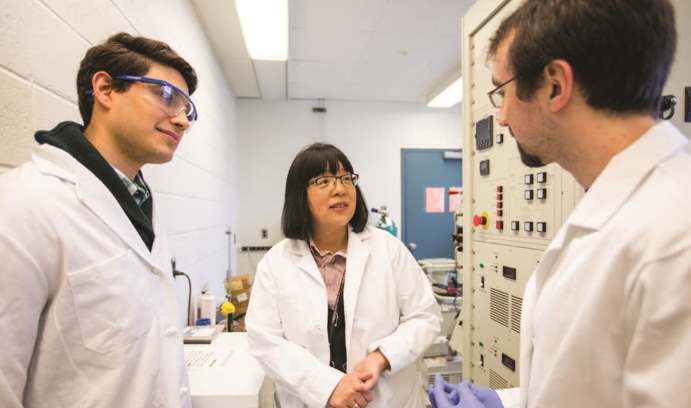The potential power of nanocomposites

Kevin Anderson, Helen Chan and Michael Kracum perform tests inside a scanning electron microscope to characterize the mechanical properties of a mixed oxide of copper and aluminum.
Ceramic-metal composites are widely used in microelectronic, automotive and aerospace applications. They have the potential to combine the hardness and high wear resistance of ceramics, and the toughness, ductility and good electrical and thermal conductivity of metals.
Helen Chan and Rick Vinci are investigating the microstructure development and mechanical behavior of novel ceramic-metal composites. They have experimented on oxides with two individual metal ions, such as barium titanate, whose metals have different affinities for bonding with oxygen.
As a result of this difference, says Vinci, who directs the Center for Advanced Materials and Nanotechnology, only one of the metal ion types stays bonded to the oxygen during reduction. This processing strategy is fundamentally different from conventional methods, in which metals and ceramics are mixed and consolidated.
The goal of the two researchers is to develop a new class of ceramic-metal nanocomposites, whose nanoscale features give rise to superior mechanical properties, as well as novel electrical and magnetic behavior. The project is funded by NSF.
Some oxide combinations appear better suited to the partial reduction process than others. Graduate student Michael Kracum has demonstrated interesting results using a mixed oxide of copper and aluminum.
Using scanning and transmission electron microscopies, the researchers have found that on reduction of CuAlO2, the copper forms discrete nanoparticles embedded just nanometers apart in the oxide.
“This intimate arrangement of the copper and ceramic phases would be almost impossible to achieve by conventional processing,” says Chan, who chairs the department of materials science and engineering.
Micromechanical tests, in which specimens of micron-sized dimensions are deformed inside a scanning electron microscope (SEM), are ongoing to characterize the composite material’s mechanical behavior.
Chan and Vinci believe that many more mixed oxide pairings of interest exist, and this is being pursued by Kevin Anderson in his doctoral research. Ultimately, the goal is to tailor the arrangement and composition of the metal and ceramic components to achieve a nanocomposite with unique properties.
Posted on:

